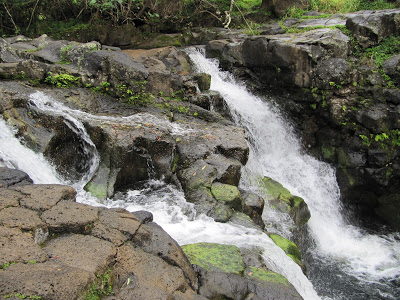by Nina
 |
| Hidden Waterfall by Brad Gibson
“At ninety-three, he could still perform difficult asanas–including variations on the headstand many younger “masters” could not. When he was ninety-five, however, he fell and broke his hip. Because of the reputation of Krishnamacharya, several leading surgeons offered to operate—but he would have none of it. Instead, he rigged up pulleys and ropes by his bed and began to experiment with new Yogic techniques for his own rehabilitation. Within two months he was able to walk, but the loss of full freedom of movement depressed him.” —from Health, Healing and Beyond by T.K.V. Desikachar (about his father Krishnamacharya) In Baxter’s post yesterday When to Transition to a Gentler Practice, he quoted a letter we received from a reader asking for advice about when to transition to a gentler asana practice. This is not the first time we’ve received such a question; in fact, this is probably the most frequent question we get here on Yoga for Healthy Aging. I suspect that most people with this question are hoping for some kind of formula from us, saying for example, if you can no longer do x, y, and z poses, it is time for your transition or most people should make the transition by age 65. But as I said to Baxter, I really feel that if you are asking the question, it’s not time yet. Because when the time comes, you will know it. Maybe you will be like Krishnamacharya, who had to change when he was 95. Or maybe you will need to transition much earlier, the way I did. |
In my forties I had a rather strong, what I like to call “semi-fancy” asana practice. I took an advanced yoga class, did challenging poses like arm balances, full Lotus, advanced backbends, etc., practiced about two hours a day, and did long inversions almost every day (including a ten-minute headstand with variations and a ten minute Shoulderstand). I quite enjoyed the athleticism of my practice, and the feeling of strength and physical wellbeing it brought to me. By my fifties, however, I developed certain physical problems, probably brought on by menopause, which forced me to change my practice. Mild arthritis in my right hip meant that I could no longer do Lotus or even half Lotus and that I had to start using props in certain other poses. And two rounds of frozen shoulder (who knew you could get it more than once?) temporarily restricted my range of motion in my shoulder so that I was very limited in what I could do with my upper body, and after the frozen shoulders abated, I was never able to get my full range of motion back (though I’m still flexible in that area, compared to some).
I practiced asana throughout all these difficulties, adapting my practice as my restrictions increased and then decreased. While my shoulder was frozen, I couldn’t even do Downward-Facing Dog pose, much less Headstand, Handstand, or Upward Bow pose. So my practice was by nature very gentle. After I got better, I began to gradually ease my way back into the poses I couldn’t do with my temporary injury, and I’m still working on getting back to where I was (realizing, of course, that I may never get there).
When I was able to do Headstand again, I made a conscious decision not to do it as often or as long as I used to. I felt that it was a pose I enjoyed so much, I didn’t want to risk losing it again, and I knew that both Headstand and Shoulderstand would be pretty hard on my neck. So I decided to practice it only about twice a week and only for about 5 minutes each time, instead of the way I used to practice it. I had absolutely no scientific evidence that this was a good idea, and it was not suggested to me by any of my teachers, it was just a feeling I decided to follow. And it can’t hurt to be cautious, right? Removing the long inversions from my practice also made it shorter, so now my practice is more in the 1 1/2 hour range (and sometimes shorter, if I’m tired). As it happens, I never had to leave my regular (intermediate) yoga class. That’s partly because I know how to make modifications to my poses (or do alternatives) when there is something I can’t do. But it’s also because my teacher has been very supportive and understanding. (Once he said something about me—thank you, Donald—that I’ll never forget: “Nina never gives up!”)
The point is, my transition has been a very organic process, in which I’ve responded to signals from my body (some rather loud, others perhaps not) and made adaptations along the way. It hasn’t all been a one-way process, either. During times of difficulty, my practice was very gentle, and when I was more able, I returned to a stronger practice. And I also know, the transition process is not over yet. Who knows what the future holds. Will I be still be doing Headstand at 95 like Krishnamacharya? Or will I have to give it up much earlier?
Baxter, too, has gone through a similar process, with physical problems (including a touch of hip arthritis) prompting him to modify his practice. And that’s how I think it will turn out for most of you, dear readers. Perhaps you will have an injury or illness that forces you to change your practice, either temporarily or permanently. Or perhaps you will simply reach a point (who knows at what age?) when you can just no longer do the poses you used to be able to do or get through an entire class the way you used to, and you’ll know deep down inside that now is that time for a change. Like the future, this process is both inevitable and completely unpredictable. But it is your own body that will guide you through it.
Follow Yoga for Healthy Aging on Facebook ° To order Yoga for Healthy Aging: A Guide to Lifelong Well-Being, go to Amazon, Shambhala, Indie Bound or your local bookstore.


After class the other day someone asked about headstand, which I never teach. I mentioned that this can be done with two chairs, the shoulders on the seats with the head dangling in between. After demonstrating, one student in her early 60s asked to try it. I helped her into position. She was happy to complete the practice with my assistance. Someone else asked, "Now what it that good for?" Someone said, "I think it's for aging." I said, "No, it's just to make you feel cool." Everyone laughed. If I left that comment hanging, can you imagine how many people would have gone home and tried it? Teaching students that aging is a time for reflection and wisdom is difficult in this culture where it's all about being young, young, young. Yoga asana is about freeing the body so it doesn't bother you when you become still and silent. In this stillness and silence, one can accept aging, coming into contact with something greater than the physical. As we age asana becomes a tool to move on to that other place. This is what I try to teach. Yes, asana is important, but let's face it, upside down is fun and makes the ego feel like it's done something really cool. And what do most (not all) people come to love about yoga? Savasana! That is the big clue!
Thank you for your article and this blog! I have been working on trusting myself and my body to know how to take care of myself, though it's difficult at times because there is so much information out there on the "right" way to do it. I also fall into wanting to look a certain way, so weeding out the many voices to hear what my body/spirt wants to do can be tricky. I too now love Savasana!
It can be a problem finding a class at the right level when someone wants to move to a gentler practice. Classes for beginners can be boring for someone who has practiced for many years. I have tried classes labelled “for all levels” only to find that the teacher spends a lot of time teaching advanced poses while the few of us who don’t/can’t do them are expected to sit and watch.
I wish that more studios would realize the enormous market out there for gentle yoga.